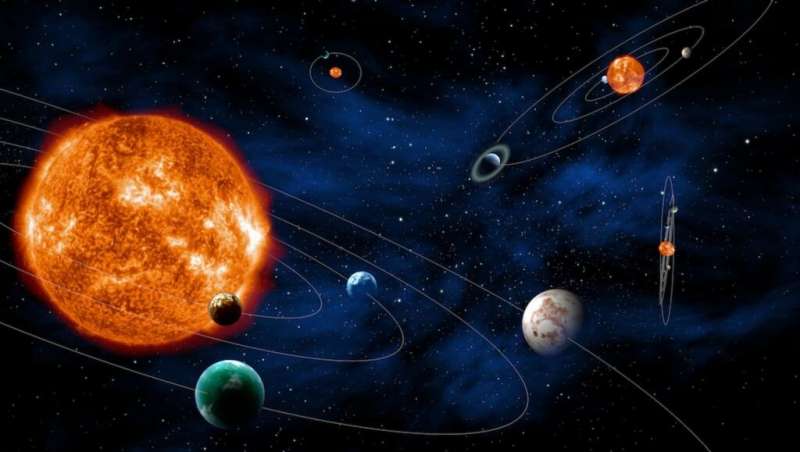This article has been reviewed according to Science X's editorial process and policies. Editors have highlighted the following attributes while ensuring the content's credibility:
fact-checked
preprint
trusted source
proofread
Can we predict if a system will have giant planets?

Prediction is one of the hallmarks of scientific endeavors. Scientists pride themselves on being able to predict physical realities based on inputs. So it should come as no surprise that a team of scientists at Notre Dame has developed a theory that can be used to predict the existence of giant planets on the fringes of an exoplanetary system.
The theory, developed by Matthias He and Lauren Weiss and posted on the arXiv pre-print server, is based upon synthesizing two datasets that, while they are created by looking for the same things, go about them in very different ways. Exoplanet searchers use two fundamental types of search methodology to look for planets—transits and radial velocity measurements.
Transits calculate the dip in a star's brightness while a planet passes in front of it. Telescopes that use transits, such as Kepler, are particularly good at finding fast-moving planets in the "inner" part of the exoplanetary system—typically because those planets move quickly in front of the star and might be caught moving in front of their host star multiple times in an observational window. However, they are not so good at capturing longer-period planets that might exist beyond 1 AU—the exoplanetary equivalents of Jupiter, Saturn, and the rest of the outer solar system.
That's where radial velocity (RV) measurements come. Telescopes like the W.M. Keck Observatory, where some of the highest-fidelity RV measurements have been taken, are much better at detecting those larger exoplanets since they have a much more significant effect on their star. RV measurements calculate how much a star wobbles when affected by an exoplanet moving around it. That exoplanet doesn't necessarily have to move in front of the star for this method to work—in fact, if it moves directly between the star and the Earth, then the method doesn't work at all. But if it pulls the star to the side as part of its elliptical orbit, Keck and other telescopes like it can calculate the distance to the planet, and its expected mass, all from how much the host star moves.
Until recently, the data sets for transiting exoplanet surveys and ones that used RV were separate, which leaves a noticeable gap in astronomers' understanding of how the two methods would read the same system. So, the researchers at Notre Dame developed the Kepler Giant Planet Survey, which combined data from Kepler and Keck to analyze 63 different exoplanet systems. Most of the planets in those systems were originally found via transits, but around 20 of the 177 planets in the sample's systems were found using RV.
With their combined data sets, the researchers looked at potential tell-tale markers that could indicate an exoplanetary system has a giant planet farther out. The most obvious places, such as how many inner planets there were and how big those planets were, did not yield many results. There was no obvious correlation between the number and size of the inner planets and the existence of any outer planet in the system.
However, there was a statistically significant correlation with a lesser-known metric of exoplanets—their gap complexity. Basically, the gap complexity measures how much the space between the planet's orbits varies from one planet to another. A system with low gap complexity would have very evenly space planets, while a system with high gap complexity would have randomly spaced planets. The researchers found that having a higher gap complexity significantly increased the likelihood of a system having a giant planet in its outer solar system—one that could be found by the RV method but not by transiting.
One of the downsides of this method is that to truly calculate the gap complexity of the inner system, they had only to analyze systems with three inner planets (and hence at least two "gaps" between orbits). That limited the total number of systems in the 63 system sample with this feature down to four. However, they also found the same logic for gap complexity applied if you included the gas giant in the complexity calculation, at least for systems with only two planets in the inner solar system.
Statistical significance is indeed the gold standard for proving scientific theories—but a total sample size of four can definitely be improved upon. Data synthesis, such as the work done by Drs. He and Weiss are an excellent place to start grabbing more data. So as an increasing number of exoplanetary systems are discovered, there will be plenty more chances to prove this theory and begin to understand the impact of giant planet formation on the formation of exoplanetary systems.
More information: Matthias Y. He et al, Inner Planetary System Gap Complexity is a Predictor of Outer Giant Planets, arXiv (2023). DOI: 10.48550/arxiv.2306.08846
Journal information: arXiv
Provided by Universe Today





















